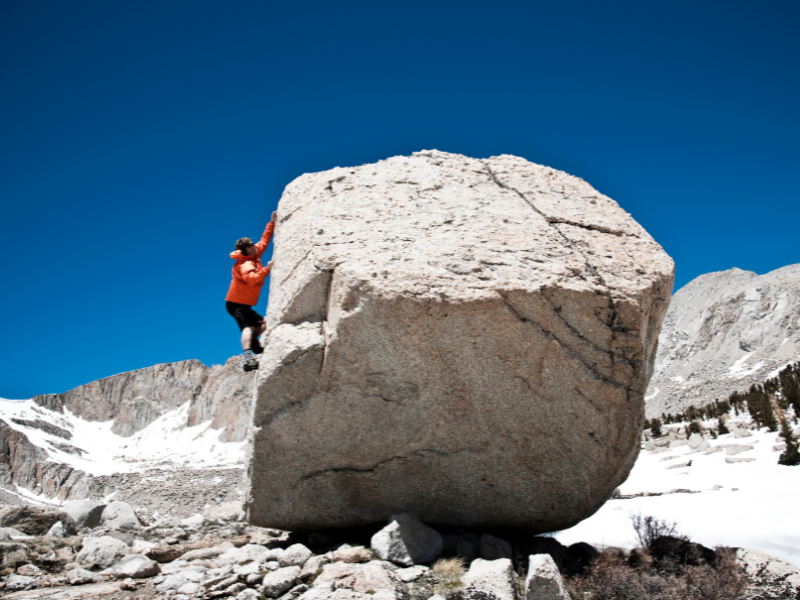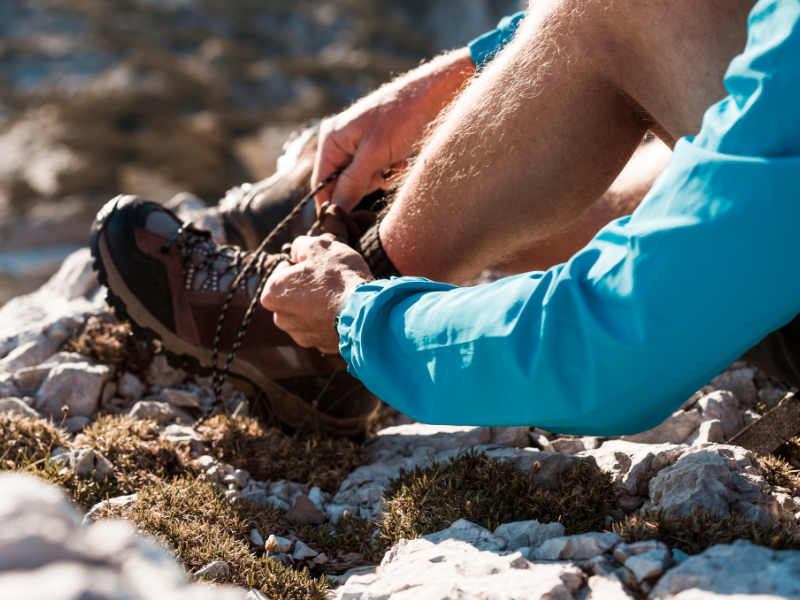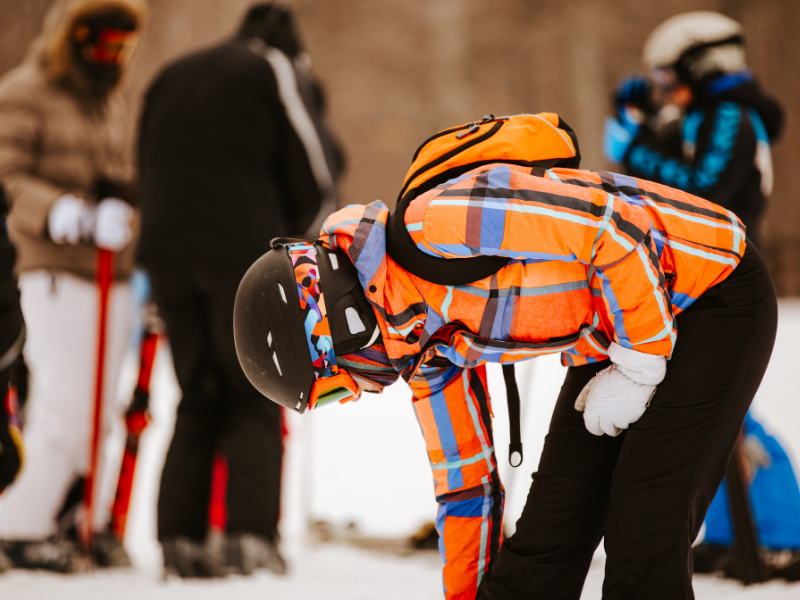If you've read Kenver's guide to scrambling, then you’ll recall that scrambling is a cross between hiking, rock climbing, and mountaineering. Yet how does scrambling differ from traditional climbing?
Scrambling and climbing are different in five primary ways:
- Scrambling is done on rocky surfaces, climbing doesn’t have to be
- Climbing almost always involves equipment
- Scrambling is multidisciplinary
- There’s often less exposure when rock climbing
- Scrambles are harder
To the unassociated, scrambling closely resembles climbing, and vice versa. And while the two activities may share a lot of commonalities, they are distinct and should be appreciated and approached as such, which is our goal here today. Let’s get started!
5 Differences Between Climbing and Scrambling
While there are certainly more than five differences between scrambling and climbing, the following list accounts for the major differences between the two activities.
This list was also built with common mislabeling in mind, that is, what observers unfamiliar with scrambling often refer to as climbing, but is actually because they don't know the difference. After reading these, you will know the difference, and you can help educate others as a result.
1. Scrambling Is Done on Rocky Surfaces, Climbing Doesn’t Have to Be
This one's pretty straightforward. When you scramble, you're on nature's ladder - rocky surfaces like talus fields, scree slopes, or boulder piles. Now, technically, you could climb many different things, including trees, a ladder, or even a set of stairs.
But that's far removed from the context of this article but is written here for a reason - we wanted to include that statement to make clear how broad of a term climbing truly is.
Even if you stick to the traditional reference of rock climbing, the definition can diverge. Are you talking about free climbing? Are you using a rope? If not, are you referencing bouldering or free soloing? If you are using a rope, is it top rope or lead?
See, that's a wide range of climbing styles that are all lumped under rock climbing. And you can pretty much do most of these indoors as well, which adds an unneeded layer to an already multi-layered definition.
The broad umbrella of rock climbing puts climbers in numerous settings.
Scrambling, by comparison, usually puts scramblers in one specific setting, which is out on steep terrain such as rocky cliffsides. Hills would count as steep terrain as well, which expands the definition somewhat.
But the scope is far more narrow for scrambling than it is for climbing. That's the first difference.
2. Climbing Almost Always Involves Equipment, Scrambling Sometimes Does
Before you go climbing, especially free climbing with a rope, you need to gather a slew of equipment to ensure your safety. Many are non-negotiables unless you're the rare breed that loves to free solo.
- Climbing Shoes: Unlike a traditional pair of athletic shoes, climbing shoes are specially designed for rock climbing, which makes them handy for climbing and scrambling alike. The shoes fit very close (like painfully close when you're breaking in a new pair) to your feet and offer minimal padding. Some are even unpadded. But this is all in an attempt to give you the most natural and intentional grip on the rock's surface.
- Climbing Ropes: By far the most important piece of equipment on a climb is a climbing rope, which allows for navigation both up and down steep rocky surfaces. Climbing ropes can be static or dynamic. A static rope is stiffer and lacks elasticity while a dynamic rope is much more elastic.
- Belay Device: A belay device is used to release or pull up the climbing rope so you can control how much rope is out during your climb. Some belay devices have assisted brakes while others are in a tubular style.
- Carabiners: Every climber knows to carry several carabiners, which are spring-loaded, lightweight metal rings that hook onto the climbing rope or your climbing gear at various points. You can use carabiners to connect your harness to gear loops or to do quickdraws.
- Chalk: For a better grip, hand chalk is a necessity when climbing. The chalk will also absorb your palm sweat. You’ll likely have to reapply the chalk several times on your climb.
- Climbing Harness: A climbing harness includes leg loops and a waistbelt so you can securely attach yourself to the rope. Even if you were to fall on a climb, between the rope and the climbing harness, you’re less likely to get seriously injured or risk death.
- Climbing Helmet: If a fall does occur, a climbing helmet can prevent serious head trauma. The helmet also protects you if overhead debris tumbles down from the cliffside.
To be a climber is to own a ton of gear - it's an expensive passion.
Even bouldering in the wild, you need shoes, a pad, chalk, and a chalk bag - which doesn't sound like much, but it's a lean version. of climbing and still requires quite a bit of gear.
So, do scramblers use all this equipment? Sometimes yes, but not often.
Of the five classes of scrambling in the US, you'd only see similar gear crop up starting in Class 3, but certainly, all Class 5's would be carrying similar gear. Or at least they should be.
Even then, scramblers will opt for equipment like ropes and harnesses, and skip most of the other gear you might use top roping.
The lack of equipment, even on moderately less difficult scrambles, does make scrambling inherently more dangerous.
3. Scrambling Is Multidisciplinary
From Kenver's guide to scrambling, you might remember that scrambling is not solely one discipline. Rather, it’s a combination of several disciplines all rolled into one challenging physical activity.
Scrambling involves elements of rock climbing, mountaineering, hillwalking, and hiking.
A scrambler has to reach a summit to climb, navigating their way there.
The hands-based approach of walking and even climbing up steep terrain involves both hillwalking and rock climbing disciplines, and the setting of scrambling is what allows for the incorporation of mountaineering.
Rock climbing may or may not incorporate elements of mountaineering as well, but relies little, if at all, on hillwalking and hiking.
4. There’s Often Less Exposure When Rock Climbing
In climbing, you’ll often hear of a term referred to as "exposure." No, this isn’t how much sun or wind exposure you get when climbing. Rather, exposure can mean one of two things.
One common definition of the term exposure is about a slope’s geographics. As an example, a south-facing slope has a southwest exposure. Much more often though, when someone talks about exposure on a climbing trail, what they mean is the injury and falling risk.
If a climbing route or problem has minimal exposure, then there are fewer fall risks. The higher the degree of exposure, the greater the risks.
Exposure isn't a static concept either - it's dynamic throughout the climb.
For instance, if a climber is scrambling or climbing up a steep cliffside and a foothold or handhold comes loose and crumbles down the side of the mountain, that ups the degree of exposure.
Thus, a trail that begins as relatively easy with low exposure can have higher exposure as climbing or scrambling progresses.
All that said, while it can vary, the consensus is that rock climbing is typically done on routes that have a lower degree of exposure. While scrambling, because of its "write your own adventure" makeup, typically comes with a higher degree of exposure.
For those keeping track, that means scrambling uses less gear and now has a higher degree of exposure. Quite the combination.
5. Scrambling Is Considered Harder
Exposure, aka risk, isn't the only superlative that scrambling has earned. Albeit somewhat subjective, there is a building belief that scrambling is more challenging as well.
The questionable part of this claim is really about the difficulty - how does one compare a problem, route, or class? Yes, scrambles and climbs are both ranked by their degree of difficulty, usually according to the same system.
But there are so many free climbing scales out there; from the Yosemite Decimal System to the Cracow Scale (also known as Kurtyka’s Scale) to Saxon Grades and more. Oh, and don't forget that different parts of the world prefer their own grading systems as well.
For example, there’s the UIAA scale, which is also known as the International Climbing and Mountaineering Federation scale (the UIAA acronym is based on the organization’s name in French).
The UIAA scale is widely favored for grading climbing difficulty in Hungary, Slovakia, the Czech Republic, Switzerland, Austria, and Germany.
So this is certainly the disclaimer sticker applied to scrambling being referred to as more difficult than rock climbing - because how does one truly compare them?
If you agree, or just want don't want to read another acronym, here's what makes scrambling difficult.
What Makes Scrambling So Challenging?
It's not just one thing really, it's the build-up of many points made above and how they collect to become scrambling.
The way you scale steep terrain when scrambling versus hiking, the increased degree of difficulty, and the lack of equipment does generally add up to an activity that demands more of your navigation abilities, climbing abilities, and sure-footedness.
Now, sit down for this one, but have you heard of a climbing scramble?
What’s a Climbing Scramble?
If you enjoy both elements of climbing and scrambling, then you don’t necessarily have to do the two activities separately. You can always participate in what’s known as a climbing scramble.
This activity combines more elements of the two - and challenges your full body. Your core, upper body, and lower body all go through the wringer. And balance and flexibility are also put to the test.
The use of equipment on a climbing scramble is common as well, as rock climbing almost exclusively relies on the equipment that we discussed earlier in this guide.
The degree of exposure is often lower than traditional scrambling, which would make a climbing scramble easier than climbing solo.
And like all climbing, scrambling, and hiking styles - you're always free to ramp up the difficulty or reduce it further according to your comfort levels.
Scrambling is Similar to Climbing, But They Have Clear Differences
Climbing and scrambling can often be confused with one another but are indeed two very different physically demanding activities.
Scrambling often eschews the use of physical equipment and might delve into steeper, more perilous terrain, so it’s widely regarded as the harder and more dangerous of the two.
Climbing, on the other hand, is a bit more versatile since it can be as easy or difficult as you want - and you can always use gear to mitigate some of the inherent dangers.
But that being said, both activities are considered extreme sports and should only be attempted by those in good physical condition with training and knowledge in the required skills.
That’s not to say that climbing is without its challenges, as it certainly has plenty. And as a lifelong boulderer, I can attest that climbing can be as easy or difficult as you want it to be.



